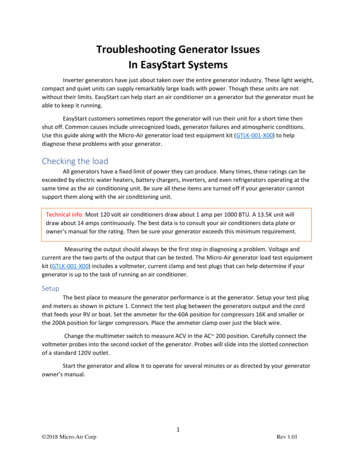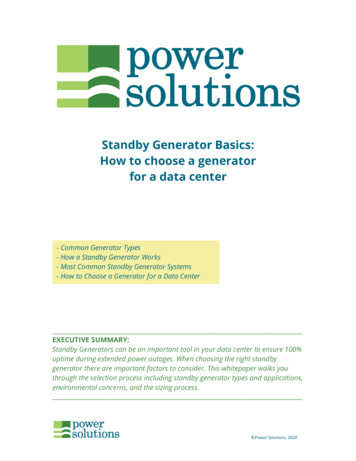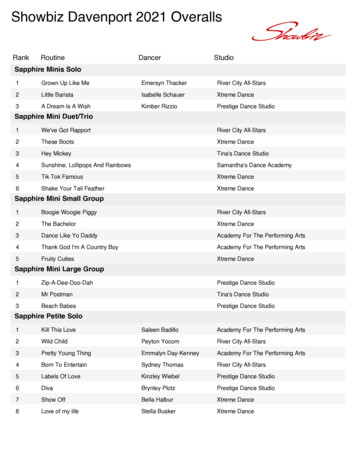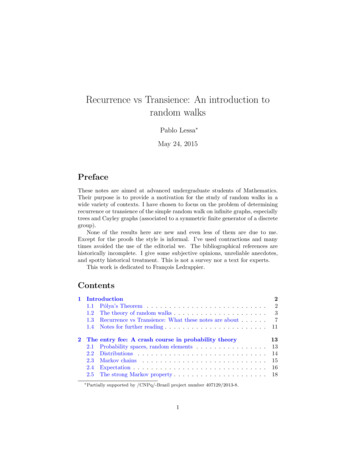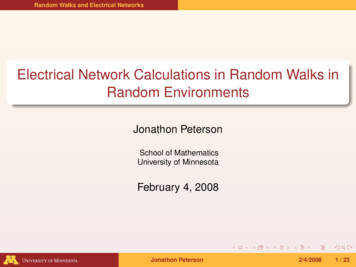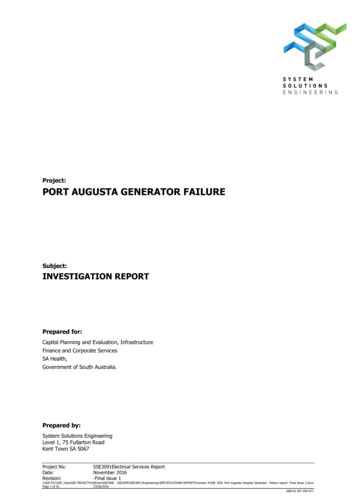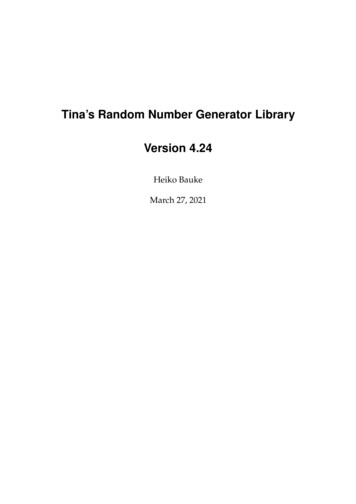
Transcription
Tina’s Random Number Generator LibraryVersion 4.24Heiko BaukeMarch 27, 2021
“The state of the art for generating uniform deviateshas advanced considerably in the last decade andnow begins to resemble a mature field.”Press et al. [63]
Contents12TRNG in a nutshell31.11.234Pseudo-random numbers for parallel Monte Carlo simulations2.12.22.32.42.534Introduction . . . . . . . . . . . . . . . . . . . . . . . . . . . . . . . . . . . . . . .History . . . . . . . . . . . . . . . . . . . . . . . . . . . . . . . . . . . . . . . . . .Pseudo-random numbers . . . . . . . . . . . . . .General parallelization techniques for PRNGs . .Playing fair . . . . . . . . . . . . . . . . . . . . . . .Linear recurrences . . . . . . . . . . . . . . . . . . .2.4.1 Linear congruential generators . . . . . . .2.4.2 Linear feedback shift register sequences . .2.4.3 Matrix linear congruential generators . . .Non-linear transformations and YARN sequences.7.7791010111515Basic concepts193.13.21922Random number engines . . . . . . . . . . . . . . . . . . . . . . . . . . . . . . . .Random number distributions . . . . . . . . . . . . . . . . . . . . . . . . . . . . .TRNG classes4.14.225Random number engines . . . . . . . . . . . . . . . .4.1.1 Linear congruential generators and variants4.1.2 Multiple recursive generators . . . . . . . . .4.1.3 YARN generators . . . . . . . . . . . . . . . .4.1.4 Lagged Fibonacci generators . . . . . . . . .4.1.5 Xoshiro type generator . . . . . . . . . . . . .4.1.6 Mersenne twister generators . . . . . . . . .Random number distributions . . . . . . . . . . . . .4.2.1 Uniform distributions . . . . . . . . . . . . .4.2.2 Exponential distribution . . . . . . . . . . . .4.2.3 Two-sided exponential distribution . . . . .4.2.4 Normal distributions . . . . . . . . . . . . . .4.2.5 Truncated normal distribution . . . . . . . .4.2.6 Maxwell distribution . . . . . . . . . . . . . .4.2.7 Cauchy distribution . . . . . . . . . . . . . .4.2.8 Logistic distribution . . . . . . . . . . . . . .4.2.9 Lognormal distribution . . . . . . . . . . . .4.2.10 Pareto distribution . . . . . . . . . . . . . . .4.2.11 Power-law distribution . . . . . . . . . . . .4.2.12 Tent distribution . . . . . . . . . . . . . . . .4.2.13 Weibull distribution . . . . . . . . . . . . . .1.252531374449505152565758626465676869717274
Contents4.34.45.6.36.4100102Hello world! . . . . . . . . . . . . . . . . . . . . . . . . . . . . . . .Hello parallel world! . . . . . . . . . . . . . . . . . . . . . . . . . .6.2.1 Block splitting . . . . . . . . . . . . . . . . . . . . . . . . . .6.2.2 Leapfrog . . . . . . . . . . . . . . . . . . . . . . . . . . . . .6.2.3 Block splitting or leapfrog? . . . . . . . . . . . . . . . . . .Using TRNG with STL and Boost . . . . . . . . . . . . . . . . . . .Using TRNG with C standard library random number facility .Implementation details and 899Prerequisites . . . . . . . . . . . . . . . . . . . . . . . . . . . . . . . . . . . . . . . 100Compilation . . . . . . . . . . . . . . . . . . . . . . . . . . . . . . . . . . . . . . . 100Running unit tests . . . . . . . . . . . . . . . . . . . . . . . . . . . . . . . . . . . . 101Examples6.16.27.Installation5.15.25.364.2.14 Extreme value distribution . . . . .4.2.15 Γ-distribution . . . . . . . . . . . . .4.2.16 B-distribution . . . . . . . . . . . . .4.2.17 χ2 -distribution . . . . . . . . . . . .4.2.18 Student-t distribution . . . . . . . .4.2.19 Snedecor-F distribution . . . . . . .4.2.20 Rayleigh distribution . . . . . . . . .4.2.21 Bernoulli distribution . . . . . . . .4.2.22 Binomial distribution . . . . . . . . .4.2.23 Negative binomial distribution . . .4.2.24 Hypergeometric distribution . . . .4.2.25 Geometric distribution . . . . . . . .4.2.26 Poisson distribution . . . . . . . . .4.2.27 Zero-truncated Poisson distribution4.2.28 Discrete distribution . . . . . . . . .Function template generate canonical . .CUDA support . . . . . . . . . . . . . . . .102104104107109113115117Efficient modular reduction . . . . . . . . . . . . . . . . . . . . . . . . . . . . . . 117Fast delinearization . . . . . . . . . . . . . . . . . . . . . . . . . . . . . . . . . . . 119Performance . . . . . . . . . . . . . . . . . . . . . . . . . . . . . . . . . . . . . . . 1198Quality and statistical tests1229Frequently asked questions157License159Bibliography160Index1652
1 TRNG in a nutshell1.1 IntroductionThe Monte Carlo method is a widely used and commonly accepted simulation techniquein physics, operations research, artificial intelligence, and other fields, and pseudo-randomnumbers (PRNs) are its key resource. All Monte Carlo simulations include some sort ofaveraging of independent samples, a calculation that is embarrassingly parallel. Hence itis no surprise that more and more large scale simulations are run on parallel systems likenetworked workstations, clusters, multicore systems or high-performance graphics cards. Foreach Monte Carlo simulation the quality of the PRN generator (PRNG) is a crucial factor. Ina parallel environment the quality of a PRNG is even more important than in a non-parallelenvironment to some extent because feasible sample sizes are easily 10 . . . 104 times as large ason a sequential machine. The main problem, however, is the parallelization of the PRNG itself.Application programmers and scientists need not to grapple with all the technical details ofpseudo-random number generation if a PRNG library is used. The following requirements arefrequently demanded from a library for (parallel) pseudo-random number generation: The library should provide a set of different interchangeable algorithms for pseudorandom number generation. For each algorithm different well tested parameter sets should be provided that guaranteea long period and good statistical properties. The internal state of a PRNG can be saved for later use and restored. This makes itpossible to stop a simulation and to carry on later. PRNGs have to support block splitting and leapfrog, see section 2.1. The library should provide methods for generating random variables with variousdistributions, uniform and non-uniform. The library should be implemented in a portable, speed-optimized fashion.If these are also your requirements for a PRNG library, you should go with Tina’s RandomNumber Generator Library.Tina’s Random Number Generator Library (TRNG) is a state of the art C pseudo-randomnumber generator library for sequential and parallel Monte Carlo simulations. Its designprinciples are based on the extensible random number generator facility that was introduced inthe C 11 standard [27, 28]. The TRNG library features an object oriented design, is easy to useand has been speed optimized. Its implementation does not depend on any communicationlibrary or hardware architecture. TRNG is suited for shared memory as well as for distributedmemory computers and may be used in any parallel programming environment, e. g., MessagePassing Interface Standard or OpenMP. All generators that are implemented by TRNG havebeen subjected to thorough statistical tests in sequential and parallel setups, see also section 8.This reference is organized as follows. In chapter 2 we present some basic techniques forparallel random number generation, chapter 3 introduces the basic concepts of TRNG, whereas3
1 TRNG in a nutshellchapter 4 describes all classes of TRNG in detail. In chapter 5 we give installation instructions,and chapter 6 presents some example programs that demonstrate the usage of TRNG in sequential as well as in parallel Monte Carlo applications. Chapter 7 deals with some implementationdetails and performance issues. We complete the TRNG reference with the presentation ofsome statistical tests of the PRNGs of TRNG in chapter 8 and answer some FAQs in chapter 9.This manual can be read in several ways. You might read this manual chapter by chapterfrom the beginning to its end. Impatient readers should read at least chapter 2 to familiarizethemselves with some basic terms that are used in this text before they jump to chapter 5 andchapter 6. These chapters deal with the installation and give some example code. Chapters 3and 4 are mainly for reference and the reader will come back to them again and again.The TRNG manual is not written as an introduction to the Monte Carlo method. It is assumedthat the reader already knows the basic concepts of Monte Carlo. Novices in the Monte Carlobusiness find further information in various textbooks on this topic [21, 66, 57, 35, 34, 52].1.2 HistoryTRNG started in 2000 as a student research project. Its implementation as well as its technicaldesign has changed several times. Starting with version 4.0 we adopted the interface proposedby [11] and finally adopted by the C 11 standard [27, 28].Version 4.0 Initial release of TRNG that implements the interface proposed by [11].Version 4.1 Additive and exclusive-or lagged Fibonacci generators with two and four feedbacktaps have been added to the set of PRNGs. Lagged Fibonacci generators do not provideany splitting facilities. TRNG implements the template function generate canonicalintroduced by [11].Version 4.2 Documentation has been revised. Minor bug-fixes to lagged Fibonacci generators.Version 4.3 Rayleigh distribution and class for correlated normal distributed random numbersadded. Changed default parameter sets for generators mrg3s, mrg5s, yarn3s, and yarn5s.The new parameter sets perform better in the spectral test.Version 4.4 Class for discrete distributions rewritten to allow efficient change of relativeprobabilities after initialization. New random number engine lcg64 shift introduced.Version 4.5 Minor improvements and bug fixes. Utility functions uniformcc, uniformco,uniformoc, and uniformoo had been reimplemented as suggested by Bruce Carneal.The new implementation of these functions is slightly faster and generates randomnumbers that are distributed more evenly in the intervals [0, 1], [0, 1), (0, 1], and (0, 1)respectively. Added support for Snedecor-F- and Student-t-distribution and the classfast discrete dist for faster generation of discrete random numbers withe arbitrarydistribution.Version 4.6 Reimplementation of generate canonical, added sequential random number en-gines mt19937 and mt19937 64 (Mersenne twister generators). All classes for continuousrandom number distributions had been reimplemented as template classes. The template parameter determines the result type and may be float, double or long double,4
1 TRNG in a nutshelldouble is the default template parameter. Bugfixes for several continuous randomnumber distributions.Version 4.7 In order to prevent name clashes macros in header file trng/config.hpp havebeen put into its own namespace TRNG. Section 6 has been extended to demonstrate howto write parallel Monte Carlo applications using TRNG and Intel Threading BuildingBlocks.Version 4.8 Performance improvements for split methods of the classes mrgn, mrgns, yarnn,and yarnns. The computational complexity has been reduced from linear (in the numberof sub-streams) to logarithmic scaling.Version 4.9 A new random number distribution class hypergeometric dist and a new ran-dom number engine class mlcg2 64 have been implemented. Performance improvementsfor split methods of the classes lcg64 and lcg64 shift. The computational complexityhas been reduced from linear (in the number of sub-streams) to logarithmic scaling.Applied various corrections1 and clarifications to the TRNG documentation. TRNGcompiles now with Sun Studio compiler. Starting from version 4.9, the TRNG library isdistributed under the terms of a BSD style license (3-clause license).Version 4.10 Two additional random number distribution classes twosided exponentialdist and truncated normal dist have been implemented.Version 4.11 TRNG starts to support parallel processing on graphics cards via the CUDAarchitecture. Various minor improvements.Version 4.12 Bug fixes and various minor improvements.Version 4.13 Bug-fix and service release.Version 4.14 Some minor changes of the class interfaces, bugfix for class binomial dist.Starting with version 4.14 we move from the class interface as proposed by [11] to theclass interface of the C 11 standard [27, 28]. These interfaces differ in some details only.Adopting the C 11 interface for TRNG allows to mix TRNG classes and classes fromthe C 11 random number library, see section 6.4 for details.Version 4.15 Bug-fix and service release. Improvements mainly related to the build system.The additional random number distribution classes maxwell dist and beta dist havebeen implemented. New e-mail address trng@mail.de.Version 4.16 Bug-fix and service release. Some bug fixes for classes discrete distributionand beta dist have been applied. (One of the corresponding bugs appeared in the classdiscrete distribution if the number of weights was a power of 2. The other bugs weresyntactical errors preventing TRNG to compile.) TRNG 4.16 features the new randomnumber distribution class negative binomial dist.Version 4.17 Bug-fix and service release.Version 4.18 The additional random number distribution class zero truncated poissondist has been implemented.1 Manythanks to Rodney Sparapani.5
1 TRNG in a nutshellVersion 4.19 Random number engines use internally integer types of exactly 32 bits or 64 bits,respectively, instead of (unsigned) long int and (unsigned) long long int. Newtypedefs for lagged Fibonacci generators have been introduced. The old ones (endingwith ul or ull) are architecture dependent and should be considered as depreciated.This and later versions will not compile on exotic platforms where none of the integertypes int, long int, and long long int has exactly 32 or 64 bits. This version beaksABI compatibility to earlier versions but retains source code compatibility.Version 4.20 Bug-fix and service release.Version 4.21 Bug-fix and service release. Fixes numerical convergence problems in the inverseof the incomplete Beta function.Version 4.22 This maintenance release removes old code for supporting C language stan-dards older than C 11. Many minor code enhancements and bug fixes have beenapplied. The autotools-based build system has been replaced by CMake to modernizethe build process and enhance portability, see installation instructions. The negativebinomial distribution has been generalized to real-valued parameters.Version 4.23 This is primarily a maintenance release focusing on code quality. Starting withthis release TRNG employs systematic unit testing on the basis of the Boost unit testframe work. The numerical accuracy of several special mathematical functions (e. g.,cumulative probability density of the normal distribution) have been enhanced. Thediscard method of the lagged Fibonacci generators has been re-implemented using analgorithm with logarithmic asymptotic complexity.Version 4.24 The two new random number engines, called xoshiro256plus and lcg64count shift, have been implemented. New unit tests have been intoduced to extendtest coverage. Special-functions unit tests use reference values with improved numericalaccuracy now. The numerical accuracy of various special functions has been improved toreach machine precision also in 128-bit floating point number arithmetic, e. g., the inversecumulative probability distribution of the normal distribution, incomplete gamma functions and the Beta function. An uninitialized memory read access has been fixed. (Manythanks to Mirai Solutions [69] for reporting this issue.) The documentation has beenimproved and extended. The chapter on quality and statistical tests has been rewrittenbased on results of the Dieharder test suite.6
2 Pseudo-random numbers for parallelMonte Carlo simulations2.1 Pseudo-random numbersMonte Carlo methods are a class of computational algorithms for simulating the behavior ofvarious physical and mathematical systems by a stochastic process. While simulating such astochastic process on a computer, large amounts of random numbers are consumed. Actually, acomputer as a deterministic machine is not able to generate random digits. John von Neumann,pioneer in Monte Carlo simulation, summarized this problem in his famous quote:“Anyone who considers arithmetical methods of producing random digits is, ofcourse, in a state of sin.”For computer simulations we have to content ourselves with something weaker than randomnumbers, namely pseudo-random numbers. We define a stream of PRNs ri in the following inan informal manner: PRNs are generated by a deterministic rule. A stream of PRNs ri cannot be distinguished from a true random sequence by means ofpracticable methods applying a finite set of statistical tests on finite samples.Almost all PRNGs produce a sequence r0 , r1 , r2 , . . . of PRNs by a recurrencer i f ( r i 1 , r i 2 , . . . , r i k ) ,(2.1)and the art of random number generation lies in the design of the function f (·). The objectivein PRNG design is to find a transition algorithm f (·) that yields a PRNG with a long periodand good statistical properties within the stream of PRNs. Statistical properties of a PRNGmay be investigated by theoretical or empirical means, see [33]. But experience shows, there isnothing like an ideal PRNG. A PRNG may behave like a perfect source of randomness in onekind of Monte Carlo simulation, whereas it may suffer from significant statistical correlationsif it is used in another context, which makes the particular Monte Carlo simulation unreliable.Numerous recipes for f (·) in (2.1) have been discussed in the literature, see [33, 40] and references therein. We will present some popular schemes and review some of theirs mathematicalproperties in sections 2.4 and 2.5. Readers how do not want to bother with mathematicaldetails might skip these sections and may come back later if necessary. However, the nexttwo sections on the parallelization of PRN sequences and on playing fair present importantconcepts of the TRNG library.2.2 General parallelization techniques for PRNGsIn parallel applications, we need to generate streams t j,i of random numbers [6, 53, 58]. Streamsare numbered by j 0, 1, . . . , p 1, where p is the number of processes. We require statistical7
2 Pseudo-random numbers for parallel Monte Carlo simulationsririt 0,it 0, it 1,it 1, it 2,it 2, iFigure 2.1: Parallelization by block splitting.Figure 2.2: Parallelization by leapfrogging.independence of the t j,i within each stream and between streams as well. Four differentparallelization techniques are used in practice:Random seeding: All processes use the same PRNG but a different “random” seed. The hopeis that they will generate non-overlapping and uncorrelated subsequences of the originalPRNG. This hope, however, has no theoretical foundation. Random seeding is a violationof Donald Knuth’s advice “Random number generators should not be chosen at random”[33].Parameterization: All processes use the same type of generator but with different parametersfor each processor. Example: linear congruential generators with additive constant b j forthe jth stream [62]:t j,i a · t j,i 1 b j mod 2e ,(2.2)where b j is the ( j 2)th prime number. Another variant uses different multipliers afor different streams [46]. The theoretical foundation of these methods is weak, andempirical tests have revealed serious correlations between streams [50]. On massiveparallel system you may need thousands of parallel streams, and it is not trivial to find atype of PRNG with thousands of “well tested” parameter sets.Block splitting: Let M be the maximum number of calls to a PRNG by each processor, and letp be the number of processes. Then we can split the sequence ri of a sequential PRNGinto consecutive blocks of length M such thatt0,i rit1,i ri M.(2.3)t p 1,i ri M( p 1) .This method works only if we know M in advance or can at least safely estimate anupper bound for M. To apply block splitting it is necessary to jump from the ith randomnumber to the (i M )th number without calculating all the numbers in between, whichcannot be done efficiently for many PRNGs. A potential disadvantage of this method isthat long range correlations, usually not observed in sequential simulations, may becomeshort range correlations between sub-streams [51, 18]. Block splitting is illustrated inFigure 2.1.8
2 Pseudo-random numbers for parallel Monte Carlo simulationsLeapfrog: The leapfrog method distributes a sequence ri of random numbers over p processesby decimating this base sequence such thatt0,i r pit1,i r pi 1.(2.4)t p 1,i r pi ( p 1) .Leapfrogging is illustrated in Figure 2.2. It is the most versatile and robust method forparallelization and it does not require an a priori estimate of how many random numberswill be consumed by each processor. An efficient implementation requires a PRNG thatcan be modified to generate directly only every pth element of the original sequence.Again this excludes many popular PRNGs.At first glance block splitting and leapfrog seem to be quite different approaches. But in fact,these are closely related to each other. Because if leapfrog is applied to any finite base sequencethe leapfrog sequences are cyclic shifts of each other. Consider an arbitrary sequence ri withperiod T. If gcd( T, p) 1, all leapfrog sequences t1,i , t2,i , . . . , t p,i ) are cyclic shifts of each other,i. e., for every pair of leapfrog sequences t j1 ,i and t j2 ,i of a common base sequence ri with periodT there is a constant s, such that t j1 ,i t j2 ,i s for all i, and s is at least b T/pc. Furthermore, ifgcd( T, p) d 1, the period of each leapfrog sequence equals T/d and there are d classesof leapfrog sequences. Within a class of leapfrog sequences there are p/d sequences, eachsequence is just a cyclic shift of another and the size of the shift is at least b T/pc.The first two methods, random seeding and parameterization, have little or no theoreticalbackup, but their weakest point is yet another. The results of a simulation should not dependon the number of processors it runs on. Leapfrog and block splitting do allow to organizesimulations such that the same random numbers are used independently of the number ofprocessors. With parameterization or random seeding the results will always depend on theparallelization, see section 6.2 for details. PRNGs that do not support leapfrog and blocksplitting should not be used in parallel simulations.2.3 Playing fairWe say that a parallel Monte Carlo simulation plays fair, if its outcome is strictly independentof the underlying hardware. Fair play implies the use of the same PRNs in the same context,independently of the number of parallel processes. It is mandatory for debugging, especiallyin parallel environments where the number of parallel processes varies from run to run, butanother benefit of playing fair is even more important: Fair play guarantees that the quality ofa PRNG with respect to an application does not depend on the degree of parallelization.Obviously the use of parameterization or random seeding prevent a simulation from playingfair. Leapfrog and block splitting, on the other hand, do allow the use of the same PRNs withinthe same context independently of the number of parallel streams.Consider the site percolation problem. A site in a lattice of size N is occupied with someprobability, and the occupancy is determined by a PRN. M random configurations are generated. A naive parallel simulation on p processes could split a base sequence into p leapfrogstreams and having each process generate M/p lattice configurations, independently of the9
2 Pseudo-random numbers for parallel Monte Carlo simulationsother processes. Obviously this parallel simulation is not equivalent to its sequential versionthat consumes PRNs from the base sequence to generate one lattice configuration after another.The effective shape of the resulting lattice configurations depends on the number of processes.This parallel algorithm does not play fair.We can turn the site percolation simulation into a fair playing algorithm by leapfroggingon the level of lattice configurations. Here each process consumes distinct contiguous blocksof PRNs form the sequence ri , and the workload is spread over p processors in such a waythat each process analyzes each pth lattice. If we number the processes by their rank i from0 to p 1 and the lattices form 0 to M 1, each process starts with a lattice whose numberequals its own rank. That means process i has to skip i · N PRNs from the sequence ri beforethe first lattice configuration is generated. Thereafter each process can skip p 1 lattices, i. e.,( p 1) · N PRNs and continue with the next lattice. In section 6.2 we investigate this approachin more detail and will give further examples of fair playing Monte Carlo algorithms and theirimplementation.Organizing simulation algorithms such that they play fair is not always as easy as in theabove example, but with a little effort one can achieve fair play in more complicated situations,too. This may require the combination of block splitting and the leapfrog method, or iteratedleapfrogging. Sometimes it is also necessary to use more than one stream of PRNs per process,e. g. in the Swendsen Wang cluster algorithm [71, 57] one may use one PRNG to construct thebond percolation clusters and another PRNG to decide if a cluster has to be flipped.2.4 Linear recurrencesThe majority of the PRNG algorithms that are implemented by TRNG are based on linearrecurrences in prime fields. Thus, we review some of theirs mathematical properties in thissection.2.4.1 Linear congruential generatorsLinear recurrences where introduced as PRNGs by Lehmer [42], who proposed the linearcongruential generator (LCG) with the recurrenceri a · ri 1 b mod m ,(2.5)with a 23, b 0, and m 108 1. Obviously, the period of such a generator cannot exceedm. If b 0 then period will be at most m 1, because ri 0 is a fixed point. In fact, theoriginal Lehmer generator has a period of only 5 882 352.The period of a LCG depends on the choice of its parameter. There are two important kindsof moduli m that allow for a maximal period, namely moduli that are a power of 2 and primemoduli. For prime moduli, a has to be a generating element of the multiplicative group modulom and b 0. While for power of 2 moduli, a and b must be odd and a 1 has to be a multipleof four. These and more theoretical properties of LCGs are presented in [33]10
2 Pseudo-random numbers for parallel Monte Carlo simulationsParallelizationOne may show by complete induction that the M-fold successive iteration of (2.5) is given byri a M ri M bM 1 a j mod m .(2.6)j 0Note that jM 0 1 a j may be computed efficiently if M is a power of 2, say M 2e , by employing2e 1 a j mod m j 0e 1 1 a2j mod m .(2.7)j 0If M is not a power of two, we can use the more general relationM 1 j 0ja mod m e 1 1 a2j aj 02eM 2e 1 a j mod m(2.8)j 0instead, where e denotes the largest integer such that M 2e . The left side as well as theright side of (2.8) include terms of the form j a j mod m, but on the rigth hand side thenumber of terms in the sum is much smaller. Applying of (2.8) recursively allows an efficientcomputation of jM 0 1 a j mod m and, therefore, an efficient implementation of block splittingand leapfrogging.2.4.2 Linear feedback shift register sequencesThe majority of the PRNG algorithms that are implemented by TRNG are based on so-calledlinear feedback shift register sequences. Therefore, we review some of theirs mathematicalproperties in this section. Readers how do not want to bother with mathematical details mightskip this as well as the next section on YARN generators and may come back later if necessary.Knuth [32] proposed a generalization of Lehmer’s method known as multiple recurrencegenerator (MRG) that obeys the recurrenceri a1 ri 1 a2 ri 2 . . . an ri n mod m(2.9)with prime modulus m. In the theory of finite fields, a sequence of type (2.9) is called linearfeedback shift register sequence, or LFSR sequence for short. Note that a LFSR sequence isfully determined by specifying n coefficients ( a1 , a2 , . . . , an ) plus n initial values (r1 , r2 , . . . , rn ).There is a wealth of rigorous results on LFSR sequences that can (and should) be used toconstruct a good PRNG. Here we only discuss a few but important facts without proofs.A detailed presentation of LFSR sequences including theorems and proofs can be found in[22, 29, 43, 44, 20, 74].Since the all zero tuple (0, 0, . . . , 0) is a fixed-point of (2.9), the maximum period of a LFSRsequence cannot exceed mn 1. The following theorem tells us precisely how to choose thecoefficients ( a1 , a2 , . . . , an ) to achieve this period [33]:Theorem 1 The LFSR sequence (2.9) over Fm has period mn 1, if and only if the characteristicpolynomialf ( x ) x n a 1 x n 1 a 2 x n 2 . . . a nis primitive modulo m.11(2.10)
2 Pseudo-random numbers f
Tina's Random Number Generator Library (TRNG) is a state of the art C pseudo-random number generator library for sequential and parallel Monte Carlo simulations. Its design principles are based on the extensible random number generator facility that was introduced in
